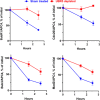Role of ubiquitin-protein ligase UBR5 in the disassembly of mitotic checkpoint complexes
- PMID: 35217622
- PMCID: PMC8892521
- DOI: 10.1073/pnas.2121478119
Role of ubiquitin-protein ligase UBR5 in the disassembly of mitotic checkpoint complexes
Abstract
The mitotic (or spindle assembly) checkpoint system ensures accurate chromosome segregation in mitosis by preventing the onset of anaphase until correct bipolar attachment of sister chromosomes to the mitotic spindle is attained. It acts by promoting the assembly of a mitotic checkpoint complex (MCC), composed of mitotic checkpoint proteins BubR1, Bub3, Mad2, and Cdc20. MCC binds to and inhibits the action of ubiquitin ligase APC/C (anaphase-promoting complex/cyclosome), which targets for degradation regulators of anaphase initiation. When the checkpoint system is satisfied, MCCs are disassembled, allowing the recovery of APC/C activity and initiation of anaphase. Many of the pathways of the disassembly of the different MCCs have been elucidated, but the mode of their regulation remained unknown. We find that UBR5 (ubiquitin-protein ligase N-recognin 5) is associated with the APC/C*MCC complex immunopurified from extracts of nocodazole-arrested HeLa cells. UBR5 binds to mitotic checkpoint proteins BubR1, Bub3, and Cdc20 and promotes their polyubiquitylation in vitro. The dissociation of a Bub3*BubR1 subcomplex of MCC is stimulated by UBR5-dependent ubiquitylation, as suggested by observations that this process in mitotic extracts requires UBR5 and α-β bond hydrolysis of adenosine triphosphate. Furthermore, a system reconstituted from purified recombinant components carries out UBR5- and ubiquitylation-dependent dissociation of Bub3*BubR1. Immunodepletion of UBR5 from mitotic extracts slows down the release of MCC components from APC/C and prolongs the lag period in the recovery of APC/C activity in the exit from mitotic checkpoint arrest. We suggest that UBR5 may be involved in the regulation of the inactivation of the mitotic checkpoint.
Keywords: cell cycle; mitosis; ubiquitin.
Copyright © 2022 the Author(s). Published by PNAS.
Conflict of interest statement
The authors declare no competing interest.
Figures




Similar articles
-
Role of ubiquitylation of components of mitotic checkpoint complex in their dissociation from anaphase-promoting complex/cyclosome.Proc Natl Acad Sci U S A. 2018 Feb 20;115(8):1777-1782. doi: 10.1073/pnas.1720312115. Epub 2018 Feb 5. Proc Natl Acad Sci U S A. 2018. PMID: 29432156 Free PMC article.
-
p31comet Promotes disassembly of the mitotic checkpoint complex in an ATP-dependent process.Proc Natl Acad Sci U S A. 2011 Feb 22;108(8):3187-92. doi: 10.1073/pnas.1100023108. Epub 2011 Feb 7. Proc Natl Acad Sci U S A. 2011. PMID: 21300909 Free PMC article.
-
Inhibitory factors associated with anaphase-promoting complex/cylosome in mitotic checkpoint.Proc Natl Acad Sci U S A. 2007 Mar 20;104(12):4870-5. doi: 10.1073/pnas.0700523104. Epub 2007 Mar 13. Proc Natl Acad Sci U S A. 2007. PMID: 17360335 Free PMC article.
-
The mitotic checkpoint: a signaling pathway that allows a single unattached kinetochore to inhibit mitotic exit.Prog Cell Cycle Res. 2003;5:431-9. Prog Cell Cycle Res. 2003. PMID: 14593737 Review.
-
Regulation of APC-Cdc20 by the spindle checkpoint.Curr Opin Cell Biol. 2002 Dec;14(6):706-14. doi: 10.1016/s0955-0674(02)00382-4. Curr Opin Cell Biol. 2002. PMID: 12473343 Review.
Cited by
-
E3-ubiquitin ligase, FBXW7 regulates mitotic progression by targeting BubR1 for ubiquitin-mediated degradation.Cell Mol Life Sci. 2023 Nov 26;80(12):374. doi: 10.1007/s00018-023-05019-9. Cell Mol Life Sci. 2023. PMID: 38008853 Free PMC article.
-
Research advancements on the involvement of E3 ubiquitin ligase UBR5 in gastrointestinal cancers.Heliyon. 2024 Apr 25;10(9):e30284. doi: 10.1016/j.heliyon.2024.e30284. eCollection 2024 May 15. Heliyon. 2024. PMID: 38707379 Free PMC article. Review.
-
The E3 ubiquitin ligase HECTD1 contributes to cell proliferation through an effect on mitosis.Sci Rep. 2022 Aug 1;12(1):13160. doi: 10.1038/s41598-022-16965-y. Sci Rep. 2022. PMID: 35915203 Free PMC article.
-
UBR5 forms ligand-dependent complexes on chromatin to regulate nuclear hormone receptor stability.Mol Cell. 2023 Aug 3;83(15):2753-2767.e10. doi: 10.1016/j.molcel.2023.06.028. Epub 2023 Jul 20. Mol Cell. 2023. PMID: 37478846 Free PMC article.
-
Cryo-EM structure of the chain-elongating E3 ubiquitin ligase UBR5.EMBO J. 2023 Aug 15;42(16):e113348. doi: 10.15252/embj.2022113348. Epub 2023 Jul 6. EMBO J. 2023. PMID: 37409633 Free PMC article.
References
-
- Musacchio A., Salmon E. D., The spindle-assembly checkpoint in space and time. Nat. Rev. Mol. Cell Biol. 8, 379–393 (2007). - PubMed
-
- Lara-Gonzalez P., Westhorpe F. G., Taylor S. S., The spindle assembly checkpoint. Curr. Biol. 22, R966–R980 (2012). - PubMed
-
- Musacchio A., The molecular biology of spindle assembly checkpoint signaling dynamics. Curr. Biol. 25, R1002–R1018 (2015). - PubMed
MeSH terms
Substances
LinkOut - more resources
Full Text Sources
Molecular Biology Databases
Miscellaneous

